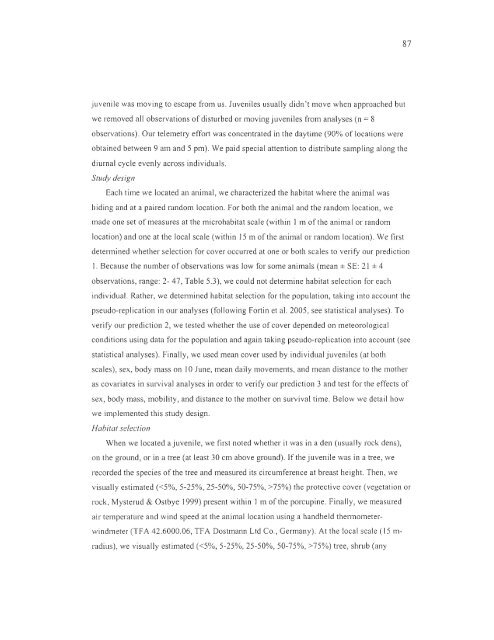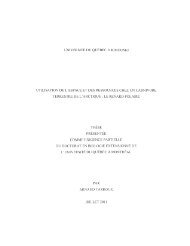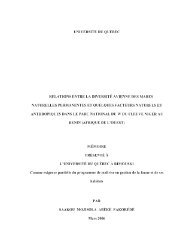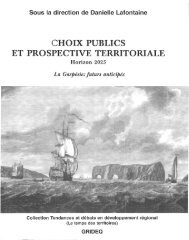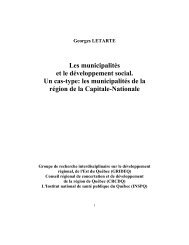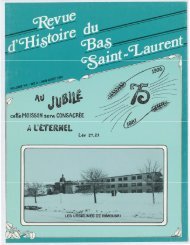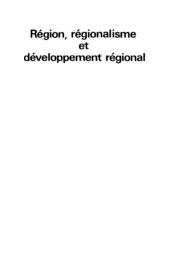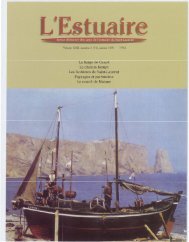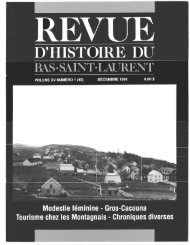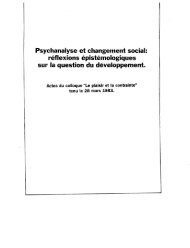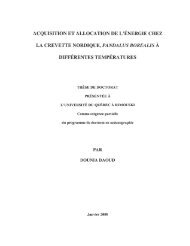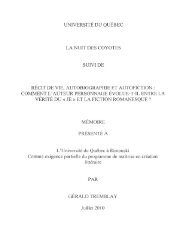influence du climat et de la prédation sur l'utilisation de l'habitat et la ...
influence du climat et de la prédation sur l'utilisation de l'habitat et la ...
influence du climat et de la prédation sur l'utilisation de l'habitat et la ...
Create successful ePaper yourself
Turn your PDF publications into a flip-book with our unique Google optimized e-Paper software.
87<br />
juvenile was moving to escape from us. Juveniles usually didn't move when approached but<br />
we removed al! observations of disturbed or moving juveniles from analyses (n = 8<br />
observations). Our telem<strong>et</strong>ry effort was concentrated in the daytime (90% of locations were<br />
obtained b<strong>et</strong>ween 9 am and 5 pm). We paid special attention to distribute sampling along the<br />
diurnal cycle evenly across indivi<strong>du</strong>als.<br />
Study <strong>de</strong>sign<br />
Each time we located an animal, we characterized the habitat where the animal was<br />
hiding and at a paired random location. For both the animal and the random location, we<br />
ma<strong>de</strong> one s<strong>et</strong> of mea<strong>sur</strong>es at the microhabitat scale (within 1 m of the animal or random<br />
location) and one at the local scale (within 15 m of the animal or random location). We first<br />
d<strong>et</strong>ennined wh<strong>et</strong>her selection for coyer occurred at one or both scales to verify our prediction<br />
1. Because the number of observations was low for some animaIs (mean ± SE: 21 ± 4<br />
observations, range: 2- 47, Table 5.3), we could not d<strong>et</strong>ermine habitat selection for each<br />
indivi<strong>du</strong>al. Rather, we d<strong>et</strong>ermined habitat selection for the popu<strong>la</strong>tion, taking into account the<br />
pseudo-replication in our analyses (following Fortin <strong>et</strong> al. 2005, see statistical analyses). To<br />
verify our prediction 2, we tested wh<strong>et</strong>her the use of coyer <strong>de</strong>pen<strong>de</strong>d on m<strong>et</strong>eorological<br />
conditions using data for the popu<strong>la</strong>tion and again taking pseudo-replication into account (see<br />
statistical analyses). Finally, we used mean coyer used by indivi<strong>du</strong>al juveniles (at both<br />
scales), sex, body mass on 10 June, mean daily movements, and mean distance to the mother<br />
as covariates in <strong>sur</strong>vival analyses in or<strong>de</strong>r to verify our prediction 3 and test for the effects of<br />
sex, body mass, mobility, and distance to the mother on <strong>sur</strong>vival time. Below we d<strong>et</strong>ail how<br />
we implemented this study <strong>de</strong>sign.<br />
Habitat selection<br />
When we located a juvenile, we first noted wh<strong>et</strong>her it was in a <strong>de</strong>n (usually rock <strong>de</strong>ns),<br />
on the ground, or in a tree (at least 30 cm above ground). ]f the juvenile was in a tree, we<br />
recor<strong>de</strong>d the species of the tree and mea<strong>sur</strong>ed its circumference at breast height. Then, we<br />
visually estimated «5%, 5-25%, 25-50%, 50-75%, >75%) the protective coyer (veg<strong>et</strong>ation or<br />
rock, Mysterud & Ostbye 1999) present within 1 m of the porcupine. Finally, we mea<strong>sur</strong>ed<br />
air temperature and wind speed at the animal location using a handheld thermom<strong>et</strong>erwindm<strong>et</strong>er<br />
(TF A 42.6000.06, TF A Dostmann Ltd Co., Germany). At the local scale (15 m-<br />
radius), we visually estimated «5%, 5-25%, 25-50%, 50-75%, >75%) tree, shrub (any


